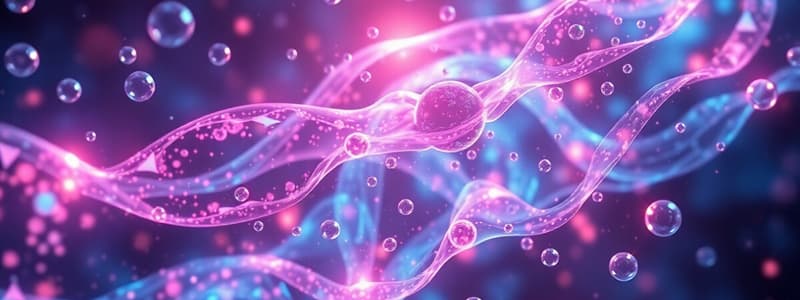Podcast
Questions and Answers
What factor is considered the most important in the absorption of a drug?
What factor is considered the most important in the absorption of a drug?
- Presence of food in the stomach
- Lipid solubility (correct)
- Total surface area of the absorption site
- Molecular weight of the drug
What does Cmax represent in pharmacokinetics?
What does Cmax represent in pharmacokinetics?
- Minimum effective concentration
- Area under the plasma concentration-time curve
- Time to reach maximum concentration
- Maximum concentration achieved by a drug dose (correct)
Which of the following statements about drug absorption is correct?
Which of the following statements about drug absorption is correct?
- Non-ionized drugs are lipid soluble in their corresponding media. (correct)
- Absorption is unaffected by the drug's chemical form.
- Ionized drugs always cross biological membranes efficiently.
- A basic drug is better absorbed in acidic media.
What is the significance of Tmax in pharmacokinetics?
What is the significance of Tmax in pharmacokinetics?
Which of the following is true regarding intravenous drug administration?
Which of the following is true regarding intravenous drug administration?
How does the area under the curve (AUC) relate to drug absorption?
How does the area under the curve (AUC) relate to drug absorption?
In a plasma concentration vs. time graph, what does MTC stand for?
In a plasma concentration vs. time graph, what does MTC stand for?
What is the relationship between drug solubility and its ability to cross biological membranes?
What is the relationship between drug solubility and its ability to cross biological membranes?
Flashcards are hidden until you start studying
Study Notes
Pharmacology
- The study of drugs.
Pharmacokinetics
- ADME study: Absorption, Distribution, Metabolism, Excretion.
Absorption
- Movement of a drug from the site of administration to the blood.
- Lipid solubility is the most important factor in absorption.
- The drug will cross the medium if the medium is the same.
- Acidic drugs are lipid-soluble and will cross the membrane when in an acidic medium.
- Basic drugs are lipid-soluble and will cross the membrane when in a basic medium.
- Acidic drugs become ionized and water-soluble in a basic medium, and will not cross the membrane.
Plasma Concentration vs Time Graph
- A graph showing the relationship between plasma concentration and time after drug administration.
- Cmax: Maximum concentration obtained by a particular dose. It should be between the minimum toxic concentration (MTC) and minimum effective concentration (MEC).
- Tmax: Time in which plasma concentration becomes maximum. This indicates the rate of absorption.
- AUC: Total area covered by the graph. This indicates the extent of absorption.
- Rate of absorption: The rate at which a drug is absorbed into the blood.
- Amount: The amount of drug absorbed over time.
- If a drug is administered intravenously (IV), bioavailability is 100%.
Studying That Suits You
Use AI to generate personalized quizzes and flashcards to suit your learning preferences.




